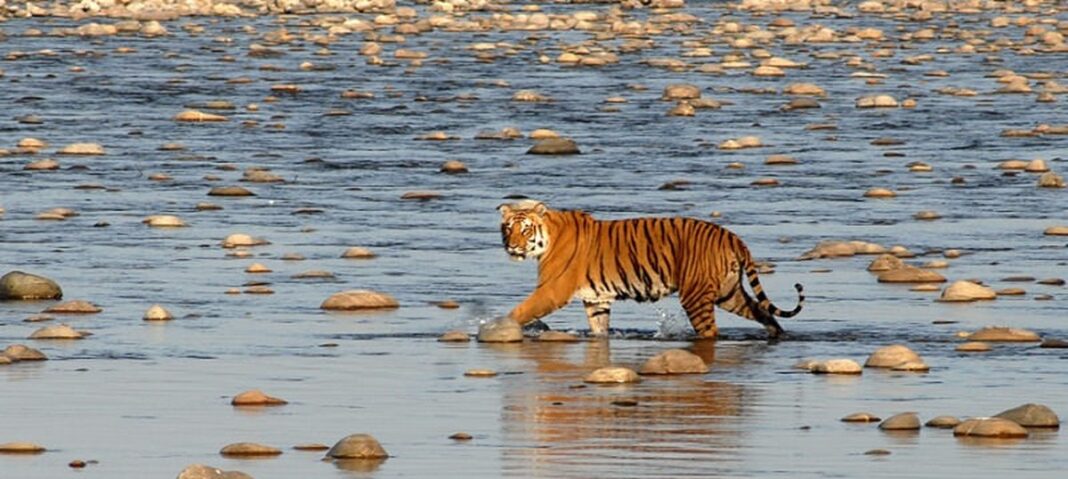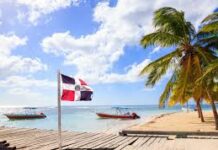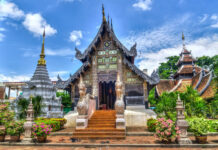“The jungle call every one of us
Only very few can understand and listen”
Sundarban is the world’s biggest delta and named from the Sundari trees and overflowed with savage snakes, crocodiles, and Royal Bengal tiger. These mangrove backwoods are recorded as a world legacy site by UNESCO and the equivalent is shaped by the conversion of the Brahmaputra, Ganges, and Meghana waterways. Life here is administered by the low and elevated tides.
WHERE IS THE SUNDARBAN?
The incredible waterways of Ganga, Brahmaputra, and Meghna channel into the Bay of Bengal in the eastern piece of India. A delta is shaped at this spot. It extends from the River Baleshwar in Bangladesh to the River Hooghly in West Bengal. That is a tremendous stretch of land (over 10,000 square kilometers) with mangrove woods, farmlands, mudflats, and desolate land. Numerous flowing streams slice through the delta. Four zones in the Sundarban are UNESCO World Heritage Sites. This is the gathering purpose of different waterways with the ocean – a gathering purpose of new stream water and the saltwater of the Bay of Bengal.
WHAT DOES THE SUNDARBAN HOLD?
There are 2 eco-districts here – the “Sundarbans freshwater swamp woodlands” and the “Sundarbans mangroves”. This is one of the 3 biggest mangrove woodlands on the planet. Loads of trees, bunches of fowls and creatures, fish and above all, riddle and sentiment. The most plentiful trees are the Sundari tree.
THE HISTORY OF THE SUNBARNS
This timberland has seen a ton of history. Directly from the second and third century AD. Closer to our occasions, there are records of the Mughals renting the woods out. Indeed, many ran away to this timberland to dodge the militaries of the Mughal Emperor Akbar. At that point came the Portuguese privateers and dacoits in the seventeenth century. The British got rights over the timberland from the Mughal Emperor Alamgir II around the hour of the Revolt of 1757.
WHY SUNDARBAN IS THE BEST NATURAL HERITAGE
The Sundarbans Mangroves ecoregion on the coast shapes the offshore edge of the delta and is the world’s biggest mangrove environment, with 20,400 square kilometers (7,900 sq. mi) of territory covered. The prevailing mangrove species Heritiera fomes is privately known as or Sundari. Mangrove timberlands are not home to an incredible assortment of plants. They have a thick shade, and the undergrowth is generally seedlings of the mangrove trees. Other than the Sundari, other tree species in the backwoods incorporate Avicennia. 26 of the fifty wide mangrove species found on the planet fill well in the Sundarbans. The regularly recognizable vegetation types in the thick Sundarbans mangrove timberlands are saltwater blended woodland, mangrove clean, salty water blended backwoods, littoral woods, wet woodland, and wet alluvial grass backwoods. The Bangladesh mangrove vegetation of the Sundarbans contrasts significantly from other non-deltaic seaside mangrove woods and upland backwoods affiliations. In contrast to the previous, the Rhizophoraceae are of minor significance.

1.THE SIGNIFICANT DRAW – THE ROYAL BENGAL TIGER
These backwoods house the Royal Bengal Tiger (Panthera Tigris) and other little felines like the Jungle feline, Fishing feline, and Leopard feline. Peculiarly, the tigers here live and swim around. Their prey is common, deer, pig, and monkeys. There are an expected 180 tigers here. Also, around 30,000 spotted deer. Numerous residents live in and around the backwoods. They live off the backwoods and its produce – fish, nectar, wood, and so on There is some man-creature struggle with such closeness… About 30-100 human lives are lost because of this consistently.
2. THE BIRDS OF SUNDARBAN
Near 300 types of flying creatures, including numerous endemic species, make this their home. There are the endemic earthy colored winged kingfishers, the concealed balance feet, ospreys, ocean hawks, and fish falcons… also, the ibis, the storks, water hens, kites, coots, pelicans.
3. THE ANIMALS OF THE WATER
Again, beyond any reasonable amount to name – from crocodiles to sawfish, different turtles, and snakes from the King cobra to snakes and pythons… Fish are in abundance from the eels to the shrimps, mudskippers, and even the Gangetic dolphins.
4. THE ODD MUDFLATS OF THE SUNDARBAN
The mudflats are framed by the wave movements, flowing cycles, and flows in the coasts. They change with the rainstorm and cyclonic developments that are normal here. Each rainstorm, the majority of this delta goes submerged for around a half year. This leaves dregs on the land when the water subsides. Coincidentally, because of the entirety of this, a freshwater redirection (and thus expanded saltiness), human improvement exercises, environmental change, rising ocean levels, and structural development, the Sundarban coast is withdrawing by around 200 meters each year.

5. THE SIGNIFICANCE OF THE SUNDARBAN
Fishing, shrimp culture, woodland produce like lumber, and the other action contributes immensely to the economy of the area. All the more significantly, the timberland gives the environment to numerous creatures and winged animals and even filters water. It is additionally a tempest boundary for this locale that is attacked by twisters consistently. Furthermore, the travel industry is a serious maturing draw here.
6. THE THREAT TO THE SUNDARBAN
The biological quality and biodiversity of the woods are going down. Furthermore, there is a loss of species. This is regardless of laws prohibiting poaching, and so forth the danger is from human eagerness and mechanical undertakings coming up close by. As additionally normal causes like twisters, rising ocean levels, and decrease in new water gracefully.
7. CULTURE AND BELIEFS
Local people love different woodland Gods and Goddesses here. For example, there is Manasa, the god of snakes. Or then again, the much-followed Bon Bibi (Goddess of the Forest). They are praised and implored through numerous people moves and tunes. Truth be told, regardless of whether it be a convention, custom, tune, move, or petition, the woods is never a long way from it.
8. THE LEGEND OF THE BON BIBI
The name is a real sense interprets as “Woman of the Forest”. The most mainstream story is that she was an Arabian Sufi holy person’s girl who went to the Sundarban. She struggled with the wretched Dokkhin Rai who murdered local people as a tiger. The plan is that Dokkhin Rai would not murder any individual who appealed to Bon Bibi. This proceeds even at this point.
9. BOOKS ON SUNDARBANS
Numerous books and works of current fiction, both people and something else depicts or are set in this land. For example, the Manasamangal (a Bangla people novel), Emilio Salgari’s Mystery of the Black Jungle, Salman Rushdie’s Midnight’s Children, and so forth
GENERAL VALUES
1. BRIEF UNION
The Sundarbans located near the Baleshwar in the East and the Harinbanga in the West, connecting to the Bay of Bengal, is the biggest adjoining mangrove woods on the planet. Lying between scope 21° 27′ 30″ and 22° 30′ 00″ North and longitude 89° 02′ 00″ and 90° 00′ 00″ East and with an all-out territory of 10,000 km2. The land region, including uncovered shoals, involves 414,259 ha (70%) with water bodies covering 187,413 ha (30%).
The three natural life safe-havens in the south cover a zone of 139,700 ha and are viewed as center rearing territories for various imperiled species. Arranged in a one of a kind bioclimatic zone inside an ordinary geological circumstance in the beachfront district of the Bay of Bengal, it is a milestone of the old legacy of fanciful and verifiable functions. Offered with superb grand magnificence and normal assets, it is universally perceived for its high biodiversity of mangrove vegetation both ashore and water.
The colossal flowing mangrove timberlands of Bangladesh’s’ Sundarbans Forest Reserve, is in actuality a mosaic of islands of various shapes and sizes, perpetually washed by salty water shrilling in and around the unending and awesome mazes of water channels. The site underpins outstanding biodiversity in its earthbound, sea-going, and marine territories; going from miniature to large scale vegetation. The Sundarbans are of general significance for internationally imperiled species including the Royal Bengal Tiger, Ganges and Irabati dolphins, estuarine crocodiles, and the fundamentally jeopardized endemic stream reptile (Batagur Baska). It is the main mangrove environment on the planet for Panthera Tigris species.
2. ECOLOGICAL VALUE:
The Sundarbans gives a critical case of on-going biological cycles as it speaks to the cycle of delta arrangement and the ensuing colonization of the recently shaped deltaic islands and related mangrove networks. These cycles incorporate storm downpours, flooding, delta development, flowing impact, and plant colonization. As a component of the world’s biggest delta, framed from silt kept by three extraordinary waterways; the Ganges, Brahmaputra, and Meghna, and covering the Bengal Basin, the land has been shaped by flowing activity, bringing about particular physiology.
3. SOLIDITARY OF DIVERSITY
One of the biggest leftover regions of mangroves on the planet, the Sundarbans upholds an extraordinary degree of biodiversity in both the earthly and marine conditions, including critical populaces of universally imperiled feline species, for example, the Royal Bengal Tiger. Populace censuses of Royal Bengal Tigers gauge a populace of between 400 to 450 people, a higher thickness than some other populace of tigers on the planet.
The property is the main excess environment in the lower Bengal Basin for a wide assortment of faunal species. Its excellent biodiversity is communicated in a wide scope of vegetation; 334 plant species having a place with 245 genera and 75 families, 165 green growth, and 13 orchid species. It is likewise wealthy in fauna with 693 types of natural life which incorporates; 49 warm-blooded creatures, 59 reptiles, 8 creatures of land and water, 210 white fishes, 24 shrimps, 14 crabs, and 43 mollusks species. They differed and beautiful flying creature life found along the streams of the property is perhaps the best fascination, including 315 types of waterfowl, raptors, and woodland fowls including nine types of kingfisher and the grand white-bellied ocean falcon.
4. RESPECTABILITY
The Sundarbans is the greatest delta, backwater, and flowing marvel of the district and hence gives assorted territories to a few several aquatics, earthly and land and water proficient species. The property is of adequate size to enough speak to its impressively high flower and faunal variety with all key qualities included inside the limits. The site incorporates the whole scene of mangrove living spaces with a satisfactory encompassing zone of oceanic (both marine and freshwater) and earthbound territories, and hence all the zones basic for the drawn-out preservation of the Sundarbans and its rich and unmistakable biodiversity
The World Heritage property is contained three natural life asylums that structure the center reproducing zone of various types of imperiled untamed life. Regions of remarkable characteristic excellence, ethnos herbal interest, unique marine faunal interest, streams, brooks, islands, swamps, estuaries, mud pads, and salt marshes are additionally remembered for the property. The limits of the property secure all significant mangrove vegetation types, territories of high flower and faunal values, and significant flying creature zones. The uprightness of the property is additionally improved by earthbound and oceanic cradle zones that encompass, yet are not part of the recorded property.
Characteristic disasters, for example, tornadoes, have consistently presented dangers on the estimations of the property and alongside saline water interruption and siltation, stay expected dangers to the qualities. Twisters and tsunamis cause some harm to the woodland along with the ocean land interface and have recently caused intermittent significant mortality among certain types of fauna, for example, the spotted deer. Over misuse of both wood assets and fauna, illicit chasing and catching, and rural infringement additionally present genuine dangers to the estimations of the property and its general trustworthiness.
ASSURANCE AND THE EXECUTIVES PREREQUISITES
The property is made out of three natural life safe-havens and has a background marked by viable public lawful security for its territory, backwoods, and sea-going climate since the mid-nineteenth century. Every one of the three natural life safe-havens was set up in 1977 under the Bangladesh Wildlife (Preservation) (Amendment) Act, 1974, having first been gazetted as timberland saves in 1878. Alongside the Forest Act, 1927, the Bangladesh Wildlife (Preservation) (Amendment) Act 1974, control exercises, for example, passage, development, fishing, chasing, and extraction of woodland produces. Various field stations set up inside Sundarbans West help with giving offices to the executive’s staff. There are no perceived nearby rights inside the held timberland with section and assortment of wood items subject to licenses gave by the Forest Department.
The property is right now all around overseeing and consistently checked by setting up the board standards, ordinary staff, and individual authoritative units. The critical target of the board is to deal with the property to hold the biodiversity, stylish qualities, and honesty. A sensitive equilibrium is expected to keep up and encourage the environmental cycle of the property on an economical premise. Another key administration need is the support of progressing natural and hydrological measures which could somehow be compromised by continuous formative exercises outside the property. Subject to a progression of progressively more extensive administration plans since its announcement as held woods, a central purpose of a large number of these plans is the administration of tigers, along with other untamed life, as a necessary piece of timberland the executives that guarantees the feasible gathering of backwoods items while keeping up the waterfront zone such that addresses the issues of the nearby human populace. The working designs for the Sundarbans exhibit a reformist expansion in the comprehension of the administration necessities and the intricacy of solutions made to meet them.
An extensive examination has been led on the Sundarban’s untamed life and biological system. Global info and help from WWF and the National Zoological Park, the Smithsonian Institution just as different associations has helped with the improvement of working designs for the property, zeroing in on protection and the executives of untamed life.
The Sundarbans give maintainable occupations to a large number of individuals in the region of the site and goes about as a sanctuary belt to shield the individuals from storms, twisters, flowing floods, ocean water drainage, and interruption. The zone gives occupation in specific seasons to enormous quantities of individuals living in little towns encompassing the property, working differently as wood-cutters, angler, nectar finders, leaves, and grass finders.
The travel industry numbers remain moderately low because of the troublesome access, masterminding transport, and an absence of offices including reasonable convenience. Mass the travel industry and its effects are probably not going to influence the estimations of the property. While the lawful security managed the cost of the property deny various exercises inside the limits illicit chasing, lumber extraction, and rural infringement present expected dangers to the estimations of the property. Tempests, typhoons, and flowing floods up to 7.5 m high, while highlights of the zones, additionally represent an expected danger with conceivable expanded recurrence because of environmental change.
SPOTS WHICH MAKES SUNDARBAN SPECIAL
PAKHIRALAYA
This is a delightful island simply near Sajnekhali Island. A large portion of boats from Gosaba, Godkhali, and Dhamakhali take a stop here before beginning the wilderness journey. At the point when we strolled in the town market of Pakhiralaya, it was 5 PM. From pier Ghats, we could see the inaccessible perspective on Sajnekhali. It is the inverse of the waterway. In Pakhiralaya Island, we checked 2-3 lodgings for the night remain. At last, we chose Hotel Mangrove Inn. We booked 18-bed quarters for the night remain. It was a decent quarter with adequate space and 4 latrines. The food counter was situated in inverse grass in the nursery. Truth be told, this my first experience to remain at residence. All families were sharing apprehensions and fun about the upcoming wilderness experience. We went bed right on time for recapturing full energy for the upcoming day-long voyage somewhere inside the wilderness.
SUDHANYAKHALI WATCH TOWER
Sudhanyakhali Watchtower is the ideal spot from where a natural life monstrosity can detect a tiger. The watch pinnacle can hold 25 individuals all at once. There is a lake having sweet water behind the watchtower. Wild creatures use to come and drink water now. There is tremendous prairie behind the lake which blesses an animating site of the wilds. Other than the tigers, one can likewise spot other natural life species, for example, crocodiles, wild pigs, and pivot deer.
SUNDARBAN NATIONAL PARK

Sundarbans was remembered for the rundown of the World Heritage Site. The most extraordinary portion of Sundarbans identifies with the way that it is the biggest mangrove woodland on the planet with an enormous centralization of Royal Bengal Tigers. About 78 types of mangroves are recorded over the backwoods. It likewise assumes an essential function in the endurance of marine living beings as it fills in as a wetland nursery to them.
The pride of West Bengal, India, Sundarbans covers a territory of around 10,000 square km in the delta of Ganges. It lies in the south-east of Kolkata and fringes the Bay of Bengal. This awesome biosphere saves houses numerous uncommon and jeopardized creatures including sea-going warm-blooded animals, tigers, fowls, and reptiles. Sundarbans is chiefly situated at the juncture of Ganga and Brahmaputra bowl in the middle of India and Bangladesh.
WILDLIFE OF SUNDERBANS

The Sundarbans woodland is home to more than 250 tigers. The Royal Bengal Tigers have adjusted to the saline and water environs and are incredibly acceptable swimmers. As you enter the gutsy wild place where there is the Sundarbans, you will be excited to see the chital deer and rhesus monkey. The water fauna of Sundarbans incorporates an assortment of fish, red fiddler crabs, and recluse crabs. There are crocodiles, which can be regularly observed along the mud banks. Sundarbans National Park is likewise noted for its protection of the Ridley Sea Turtle. A mind-boggling assortment of reptiles is additionally found in Sundarbans – these incorporate lord cobras, the stone python, and the water-screen. The imperiled stream reptile, Batagur Baska, is found on the Mechua Beach while woofing deer are discovered distinctly on Halliday Island in the Sundarbans.
SAJNEKHALI WATCH TOWER
Sajnekhali Watch Tower is the most prominent watchtowers. The purpose of its fame is its nearness to various retreats in the Sundarban region. This spot likewise fills in as the administrative center of the woodland office. A vacationer can get the authorization to enter the public park from this spot as it were. The watch pinnacle can oblige 20 individuals all at once. The main attractions in this area, the Mangrove Interpretation Center, and the traveler cabin of the Bengal Tourism Department. This watchtower makes investigating the wild fun and simple. Particularly, the feathered creature sweethearts get a unique display of avifauna species, for example, Pelican, Kingfishers, Plovers, Lap Wings, White Bellied Sea Eagle, Whimbrel, Curfews, and Sandpipers.
BHAGABATPUR CROCODILE SANCTUARY
The thick mangrove timberland at the intersection of the Saptamukhi stream framework has tremendous regular excellence to pull in vacationers all consistently. This incubator of estuarine crocodile and Batagur Baska types of turtle in the undertaking has crocodiles of changing ages. Even though this spot is effectively available through Namkhana, one can likewise visit it from Sajnekhali.
BURIRDABRI WATCH TOWER
Mud strolls and mangrove confine trail prompting a viewpoint known as Raimongal View Point. The ground fauna comprising of snails, assortments of crabs, and mollusks can be noticed intently during the mud walk. The format of this lookout is excellent with one strolling over wooden scaffolds and afterward, through the mud confine lastly finishing to a wooden watch overshadow looking Bangladesh with the stream Raimongal framing the global limit among India and Bangladesh. One can see the Bangladesh Sundarbans from this lookout. This lookout can have 10 people all at once.
NETIDHOPANI
This is another lookout in the arrangement of a few watchtowers and is related to the legend of Behula and Lakhindari. Today this lookout offers one a perspective on the remains of a 400-year-old Shiva Temple. It is additionally accepted that there is a street on the outrageous right of the woods which was worked by King Pratap Aditya to monitor the waterfront territory. It is presently covered with earth. There is additionally a sweet water lake. This watchtower can have 20 people all at once.
HOLIDAY ISLAND WILDLIFE SANCTUARY
The Halliday Island Wildlife Sanctuary (likewise known as the Halliday Wildlife Sanctuary) is one of a few natural life safe-havens in the country of India. The territory is roughly six square kilometers in size. It is a piece of the Sundarbans Biosphere Reserve with the Sundarbans area in general turning into a Biosphere Reserve formally in 1989. The natural life weighty zones there are viewed as earth disapproved of traveler objective.
KALASHDEEP
Being outside the central region of Sundarbans, guests with furnished gatekeepers are allowed to get down on the seashore. During winters, it is the favorite place of the Olive Ridley Turtles that show up in extraordinary numbers on this seashore for settling. Kalash Island is additionally the home to numerous assortments of waterfront winged creatures and is extraordinarily a decent spot to spot extraordinary waders. The Great Stone-curlew or Great Thick-knee (Escalus Recurvirostris) is located on the seashore.
HENRYS ISLAND
Henrys Island is named after a European who studied land in the territory in the late nineteenth century. Examine the view from the watchtower in Bakkhali and do a stroll to the seashore. The walk experiences a stretch of mangrove wilderness got to by intersection a little bamboo connects. The fisheries office has burrowed more than 50 lakes involving more than 25 bighas on 100-hectares of land. Trees, for example, gora, Kakeru, palm, normally developing Sundari and hetal have been planted.
BAKKHALI
Bakkhali is situated on one of the numerous deltaic islands spread across southern Bengal. A large portion of the islands is important for the Sundarbans, notwithstanding a couple at the edges. A portion of these is combined with spans over restricted springs. This little island sticks out into the tremendous territory of the Bay of Bengal. The south-bound bow formed seashore of Bakkhali is one of the uncommon ones on the planet that offer incredible perspectives on both dawn and dusk.
There is an 8 km long seashore extending from Bakkhali to Frazergunj with delicately moving waves. These are twin towns currently shaping one constant territory. Aside from on a periodic occasion, the seashore isn’t packed. A little stretch close to Bakkhali has been illuminated. It is a hard sea shore appropriate for cycling or in any event, driving. One can go for long strolls with coconut water. Bakkhali is additionally the name of a stream in the Chittagong division of Bangladesh.
FRASERGANJ
Only 2 km north of Bakkhali is the twin town Frazergunj, which is named after Andrew Fraser. Fraser, in the mid-1900s, attempted to incorporate the zone with a retreat, which he couldn’t as the waves habitually washed the developments. His office remains can even now be seen here. A Wind Energy Farm that creates 1 MW and is before long going to be reached out to deliver 2 MW is situated in Frazergunj.
SOME MYTHS AND MYSTERIES ABOUT SUNDARBANS
1. LIFE, FOREST, AND LIVELIHOODS
According to the 2011 registration, the number of inhabitants in the locale was about 4.5 million with a lofty 26.5 percent populace development since 2001. As a rule, occupants are monetarily helpless living fundamentally on regular assets around them. Here, personalities and networks cut across religion and station, and are interwoven with their occupation and relationship with the woods. “O jangal kore… ” — that is the way local people allude to somebody living off the woodland. These are to a great extent negligible specialist from the most reduced of the social layers — the wood-cutters (grain) and nectar gatherers (Pauley). Fishing is a significant business here. Likewise, occupations like prawn-seed assortment (meendhara) and crab assortment from streams and creeks of the area are normally taken up by ladies and elderly people men. Every one of them faces dangers at work from tigers, snakes, and crocodiles. Nearby individuals of the Sundarbans along these lines will in general count on divine forces and fantasies to spare them from such threats prowling at each step of their lives.
Nature by and large, and the woods and the stream specifically, are what local people draw food from, and perplexingly, those are the very things from which individuals need to be secured. The lower Bengal conviction framework, of which Sundarbans is a huge district, absorbs nature with customs and legends. Individuals love plants and creatures, and customs identified with streams, lakes, downpour, collect, and woods are basic here. Legends are developed and ceremonies are performed as needs be. Folklores are of an inferior sort, made from an everyday routine experienced on the edges of society. Regular difficulties are woven into the fantasies, accounts, and customs of the network. They describe how the “feeble” is engaged regularly through perfect mediations to withstand the might of tigers and different animals of the timberland.
In certain pieces of the Sundarbans, Bonbibi is dressed like Goddess Lakshmi (left), and in others like a Sufi holy person. Dakkhin Rai takes numerous structures in this area — from a tiger-devil who governs the wilderness to a symbol or a ruler (right) and rescuer of his aficionados. Photographs: Dr. Suptendu P Biswas
In certain pieces of the Sundarbans, Bonbibi is dressed like Goddess Lakshmi (left), and in others like a Sufi holy person. Dakkhin Rai takes numerous structures in this area — from a tiger-evil presence who governs the wilderness to a symbol or a ruler (right) and hero of his aficionados. Photographs: Dr. Suptendu P Biswas
2. NUREMOUS FACES OF DAKSHIN RAI
The tiger in the Sundarbans is an indistinguishable piece of the nearby mind. It is dreaded, particularly by the individuals who adventure into the timberland to fish or gather nectar. Consistently, official figures express that at any rate 10-20 individuals who enter the timberland are slaughtered by the tiger. Local people guarantee the numbers are a lot higher. To assuage the creature, individuals look for extraordinary assistance. Maybe the custom of creature love began when the British brought networks with ancestral causes from the Chhotanagpur Plateau to free parts from the woods in the Sundarbans. They in the long run settled here. Afterward, with the happening to various networks from the territory, the human-type of the creature was received as a society divinity, progressively supplanting the “creator god” with “lord of creatures”. Two mainstream divine forces of the tiger I have seen here are Dakkhin Rai and Bonbibi.
Dakkhin Rai, the master of the tiger and a huge people divinity, is a very charming marvel. He is portrayed in the tiger-structure in certain spots and human-structure in others. Legends of Dakkhin Rai have been described in the punchy writing, specifically, Raya-Mangal wrote in the late seventeenth century following the Mangal Kavya (artistic signifying “Sonnets of Benediction”) convention. The legend discusses a woodcutter and his siblings who were slicing trees in the wilderness to make boats with the goal that their lord could begin a journey. Seeing the decimation of the backwoods, a maddened Dakkhin Rai brought his tigers to slaughter the scoundrels. The woodcutter at that point appealed to him and offered a penance to satisfy Rai and inevitably got the life of his family back. Upon their return, they shared the account of Dakkhin Rai’s genuine force, so anybody in peril could look for help from the ruler. I think that it’s intriguing how the woods, climate security, natural life, transportation, occupation, and so on are blended through a famous neighbourhood story.
I have seen two various kinds of divinities of Dakkhin Rai in this locale. In the “down” islands, he is the tiger-devil controlling the wilderness. He is a divine resembling figure and a guardian angel for his fans in parts of the uplands, where he was accepted to be a landowner, lord, the military boss, or fearless tracker shielding nearby townspeople from tigers. Another fantasy proposes that Dakkhin Rai was the child of Shiva. At the point when the head of Ganesha was cut off from his body, it fell in the southern (Dakshin) bearing to turn into the divinity of Lord Dakkhin Rai, known as Dakknineswar in certain zones of the Sundarbans. I visited an interesting sanctuary of his in Dhapdhapi in the South 24 Parganas region around 35 km away from Kolkata. Without any “unique” mantra for him, continuously his folklore has been built around both Shiva and Ganesha, and as needs be, ministers built up specific mantras and customs too.
A society execution is known as Bonbibi Pala in progress at the Gosaba block in the South 24 Parganas locale. The custom has been made due throughout the long term exclusively through oral and transcribed original copy moves across ages.
A society execution is known as Bonbibi Pala in progress at the Gosaba block in the South 24 Parganas area. The convention has been made due throughout the long term exclusively through oral and transcribed composition moves across ages.
Photograph: Dr. Suptendu P Biswas
By Rabisankar Roy, West Bengal










